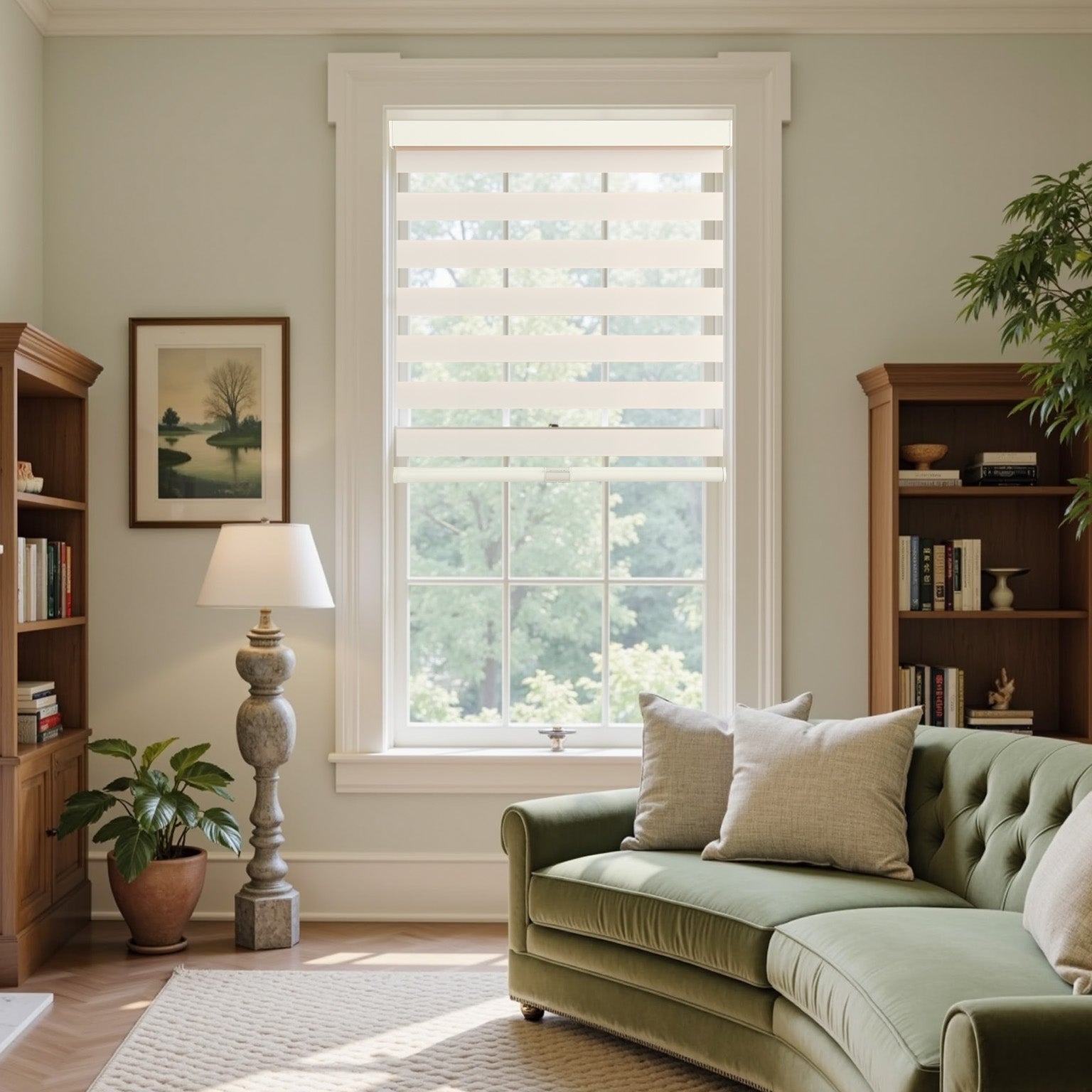When you're shopping for window treatments, zebra shades and roller shades often end up on your shortlist. Both are sleek, modern, and functional—but they work very differently. Here at AOSKY, we provide both two types and we are here for you to show you the differences so that you can choose the option that truly fits your lifestyle and home design.
What Are Roller Shades?
Roller shades are the simplest window covering available. They consist of a single piece of fabric that wraps around a tube mechanism at the top of your window. Pull down to cover, pull up to reveal. No slats, no vanes, no complications—just one continuous piece of material that rolls smoothly up and down.
Roller shades come in an enormous range of fabrics, from sheer to blackout, with countless colors, patterns, and textures. You can find everything from basic white light-filtering fabric to bold geometric prints or natural woven materials. The fabric you choose determines your level of light control and privacy.
They're incredibly popular because they're affordable, easy to install, and work with virtually any decor style. Whether you have a contemporary loft or a farmhouse kitchen, there's a roller shade that fits.
What Are Zebra Shades?
Zebra shades feature alternating horizontal stripes of sheer and opaque fabric on a single roller. As you adjust the shade, these bands move past each other, giving you the flexibility to align the sheer stripes for filtered light or the solid stripes for privacy and light blocking.
The distinctive striped appearance gives them their "zebra" nickname, though they're also called dual-layer shades, transitional shades, or banded shades. This innovative design combines the simplicity of a roller shade with adjustable light control that rivals traditional blinds.
Zebra shades offer more versatility than standard roller shades because you don't have to choose between "up" and "down"—you can fine-tune exactly how much light and privacy you want at any given moment.
Light Control: The Key Difference
This is where zebra shades and roller shades diverge significantly.
Roller shades give you an all-or-nothing approach to light control. When they're down, the amount of light entering depends entirely on the fabric opacity you selected. A sheer roller shade will filter light consistently. A blackout roller shade blocks it almost completely. But once the shade is in position, you can't adjust the light level without raising or lowering the entire shade.
Zebra shades provide variable light control without raising or lowering the shade. By aligning the sheer bands, you get soft, filtered natural light. Align the opaque bands, and you achieve near-complete darkness. You can leave the shade at the same height all day while adjusting light levels as the sun moves across your home.
For spaces where lighting needs change throughout the day—like home offices where morning glare is a problem but afternoon light is welcome—zebra shades offer superior functionality. Roller shades work better when you know exactly what level of light control you need and it stays consistent.
Privacy Options
Privacy requirements differ from room to room, and these two shade types handle it in distinct ways.
With roller shades, your privacy level is determined at purchase. Choose a sheer or light-filtering fabric, and you'll have daytime privacy with visible silhouettes at night when interior lights are on. Choose room-darkening or blackout fabric, and you get full privacy day and night—but you sacrifice natural light.
Zebra shades adapt to changing privacy needs throughout the day. Morning coffee in your pajamas? Align the solid stripes for complete privacy. Afternoon reading session? Switch to the sheer bands for natural light while maintaining a degree of privacy. Evening movie? Back to solid stripes for maximum privacy and darkness.
This flexibility means you don't have to compromise. You're not stuck choosing between "I want natural light" and "I want privacy"—zebra shades give you both, just at different times.
Design and Aesthetics
Your window treatments significantly impact your room's overall appearance.
Roller shades offer the cleanest, most minimalist look available. When raised, many models are barely visible. When lowered, they're a single, smooth expanse of fabric with no breaks or horizontal lines. This makes them ideal for showcasing bold fabric choices, beautiful patterns, or maintaining a completely neutral backdrop.
The sleek profile of roller shades works particularly well in ultra-modern spaces, Scandinavian designs, or anywhere you want the windows to disappear visually. They're also excellent for letting other design elements take center stage—if you have statement furniture or dramatic artwork, roller shades won't compete for attention.
Zebra shades create visual interest with their distinctive horizontal banding. Even when the stripes are aligned to show mostly one color, you still see subtle lines that add texture and dimension. This makes them inherently more decorative than roller shades.
The stripe pattern works beautifully in contemporary, transitional, and even some traditional spaces. It adds personality without being overwhelming. Zebra shades in neutral tones provide architectural interest while remaining versatile, while bolder color combinations can become focal points in simpler rooms.
Installation and Space Requirements
Both shade types are relatively simple to install, but there are differences worth noting.
Roller shades have the most compact profile of any window covering. The roller mechanism is small, and when raised completely, the shade takes up minimal space at the top of your window. This makes them perfect for shallow window frames, windows with limited clearance, or situations where you want maximum glass exposure when shades are open.
Zebra shades have a slightly larger roller mechanism because they accommodate the dual-layer fabric system. While still relatively compact, they take up marginally more space than basic roller shades. This rarely creates problems, but it's worth measuring if you have extremely limited mounting depth.
Both types offer inside mount (installed within the window frame) and outside mount (installed on the wall or frame facing) options. Installation typically takes 15-30 minutes per window with basic tools. The mounting hardware is straightforward, making DIY installation feasible for most homeowners.
Operation and Mechanisms
How you operate your shades daily matters more than you might think.
Roller shades typically come with these operation options:
- Spring-loaded: Pull down to lower, tug gently to raise
- Continuous cord loop: Pull one side of the loop to raise, the other to lower
- Cordless: Push up or pull down manually
- Motorized: Control with remote, wall switch, or smartphone app
Zebra shades offer the same operating mechanisms but with an important addition—you adjust them in two ways. First, you raise or lower the shade to your desired height. Then, if needed, you continue adjusting to align the sheer or opaque bands for your preferred light level. This two-step adjustment becomes intuitive quickly.
Cordless and motorized options work especially well with zebra shades because you can make fine adjustments throughout the day without dealing with cords. Motorized zebra shades offer the ultimate convenience—adjust height and light filtering from your couch or even set schedules for automatic adjustments.
Maintenance and Durability
Window treatments should be easy to keep clean and stand up to daily use.
Roller shades are incredibly easy to maintain. The single smooth fabric surface wipes clean with a damp cloth or vacuums easily with a brush attachment. There are no vanes, slats, or gaps where dust accumulates. Stains can often be spot-cleaned, and some roller shade fabrics are even machine-washable.
Because of their simple construction, roller shades have fewer parts that can malfunction. The main wear point is the rolling mechanism itself, which lasts years with normal use. Quality roller shades can easily last 7-10 years or longer.
Zebra shades require slightly more attention to keep dust-free because the horizontal stripes create subtle ridges where dust settles. Regular light dusting or vacuuming keeps them looking fresh. The alternating fabric bands mean you're cleaning a textured surface rather than a smooth one, though it's still straightforward.
The more complex mechanism of zebra shades—with fabric moving past itself—means there are more components that could potentially wear over time. However, quality zebra shades are built to handle thousands of adjustments and typically last 5-8 years or more with proper care.
Light Filtering vs. Room Darkening Options
Both shade types come in various opacity levels, but they function differently.
Roller Shades Fabric Options:
- Sheer: Maximum light, minimal privacy, UV protection
- Light filtering: Soft diffused light, daytime privacy, good UV protection
- Room darkening: Significant light reduction, good privacy, excellent UV protection
- Blackout: Nearly complete darkness, maximum privacy, total UV protection
With roller shades, you choose your opacity level at purchase, and that's what you get every time the shade is down. If you buy a light-filtering roller shade, it always filters light the same way.
Zebra Shades Versatility:
Zebra shades effectively give you two opacity levels in one shade. When sheer bands align, they function like a light-filtering roller shade. When opaque bands align, they perform like a room-darkening roller shade. This dual functionality means one zebra shade can replace two different roller shades you might otherwise need to purchase.
For rooms where your needs vary—bedrooms where you want morning light during the week but to sleep in on weekends, or living rooms where you watch TV in the evening but want natural light during the day—zebra shades offer better value because of this versatility.
Cost Comparison
Budget considerations matter for any home improvement project.
Roller shades are generally the more affordable option. Basic roller shades in standard sizes can start quite inexpensively, with prices increasing based on fabric quality, special features, custom sizing, and motorization. Even high-end designer roller shades with premium fabrics typically cost less than comparable custom solutions.
Zebra shades cost more than basic roller shades because of their more complex construction and dual-functionality design. The innovative banded fabric system and the mechanism that allows for variable light control require more sophisticated engineering and materials.
However, when you consider that zebra shades essentially replace what might otherwise require layering two different window treatments, the price difference becomes more justifiable. You're paying more upfront but getting significantly more versatility in return.
Custom sizing adds cost to both options, though standard sizes offer good savings if your windows fit common dimensions. Motorization is a premium feature for both types and adds similar amounts to the final price.
Energy Efficiency
Window treatments can help reduce heating and cooling costs.
Roller shades' energy efficiency depends entirely on fabric choice. Blackout and room-darkening fabrics provide good insulation by creating a barrier between the window and your room. They block heat gain in summer and reduce heat loss in winter. Light-filtering and sheer roller shades offer minimal insulation benefits but do reduce UV radiation that heats up your space.
Some roller shades feature specialized energy-efficient fabrics with thermal backing or honeycomb construction that significantly improves insulation. These specialty options perform better than standard roller shades for energy savings.
Zebra shades offer moderate energy efficiency. When the opaque bands are aligned, they block solar heat gain and provide some insulation. The dual-layer construction creates a small air pocket that offers better thermal performance than single-layer sheer roller shades.
However, zebra shades generally don't match the insulation properties of blackout roller shades or cellular shades specifically designed for energy efficiency. If energy savings are your primary concern, thermal roller shades or cellular shades outperform standard zebra shades.
Best Rooms for Each Shade Type
Where you install your shades influences which type works best.
Roller Shades Work Best In:
- Kitchens where you want clean, simple window treatments
- Bathrooms requiring consistent privacy
- Rooms with bold decor where you want window treatments to fade into the background
- Children's rooms (blackout options for better sleep)
- Small windows where you want minimal visual clutter
- Spaces where budget is a primary concern
Zebra Shades Work Best In:
- Bedrooms where light control needs vary by time of day and weekend vs. weekday
- Home offices requiring glare control while working but natural light when not
- Living rooms where you entertain in evenings but want natural light during the day
- Dining rooms where ambiance changes from breakfast to dinner
- Multi-purpose rooms with changing lighting requirements
- Spaces where you want window treatments to add architectural interest
Both types work well on large windows and sliding glass doors, though very wide expanses might benefit from roller shades' simpler mechanism that handles large fabric panels more easily.
Making Your Decision
Still weighing your options? Here's a quick decision guide.
Choose Roller Shades If You:
- Want the most affordable window treatment option
- Prefer ultra-minimalist aesthetics
- Need a specific level of light control that won't change
- Want the easiest possible maintenance
- Have bold patterned fabrics in mind
- Value simplicity over versatility
- Are covering many windows on a budget
Choose Zebra Shades If You:
- Need flexible light control throughout the day
- Want one shade that does the job of two
- Appreciate subtle visual interest from the stripe pattern
- Are willing to invest more for increased functionality
- Have rooms with changing light requirements
- Want modern style with practical versatility
- Prioritize adaptability over simplicity
You can also mix both types throughout your home. Use roller shades in spaces with consistent needs and zebra shades in rooms where flexibility matters most. This approach maximizes both functionality and budget efficiency.
Frequently Asked Questions
Are zebra shades more expensive than roller shades?
Yes, zebra shades typically cost 20-40% more than comparable roller shades because of their more complex dual-layer construction and adjustable light control mechanism. However, their versatility means you're getting functionality that might otherwise require two separate window treatments.
Can I get blackout performance with zebra shades?
Zebra shades provide excellent room darkening when the opaque bands are aligned, but they don't achieve true blackout like dedicated blackout roller shades. Some light may filter through where the sheer and opaque bands meet, and there's typically more light gap at the edges. For complete darkness, blackout roller shades are superior.
Which is easier to install?
Both are relatively easy to install with similar mounting hardware and processes. Roller shades have a slight edge in simplicity because their mechanism is more basic, but the difference is minimal. Most homeowners can install either type in 15-30 minutes per window.
Do zebra shades or roller shades last longer?
Quality roller shades typically last slightly longer (7-10+ years) than zebra shades (5-8+ years) because they have fewer moving parts and a simpler mechanism. However, both can last many years with proper care, and the lifespan difference isn't significant enough to be a major decision factor.
Which provides better UV protection?
Both provide good UV protection depending on fabric opacity. Roller shades in blackout or room-darkening fabrics block virtually all UV rays when lowered. Zebra shades with opaque bands aligned also block most UV radiation. For maximum UV protection, either option works well—just avoid sheer fabrics if UV blocking is your priority.



